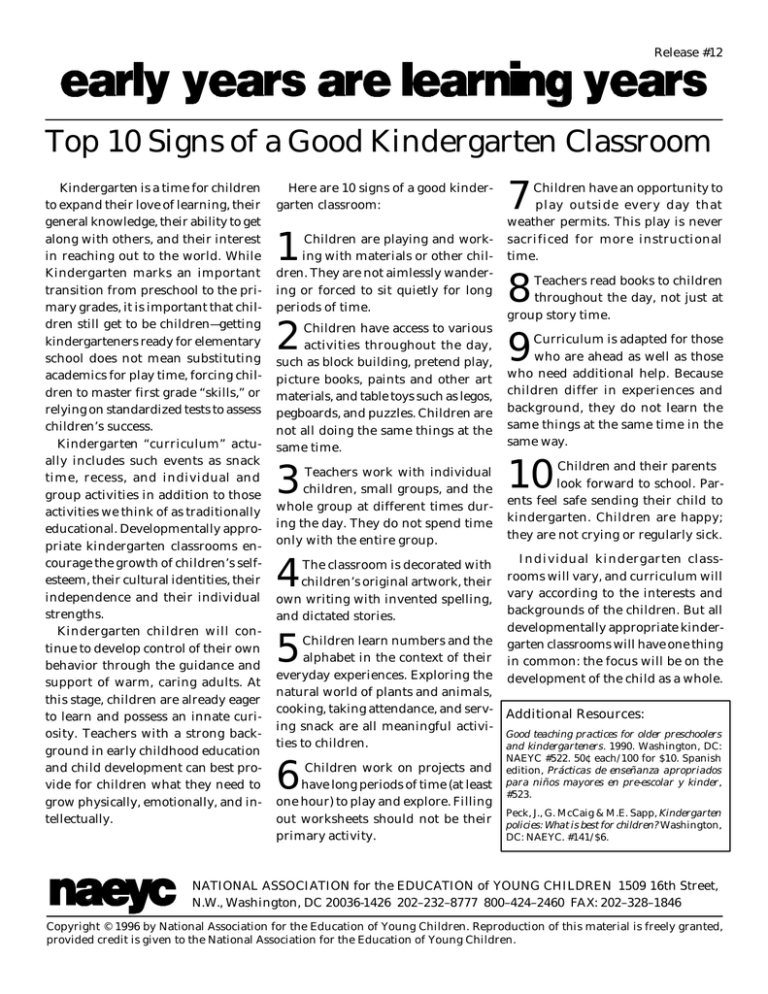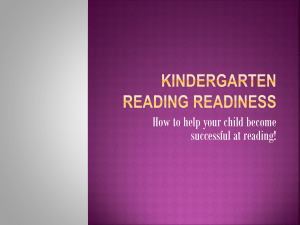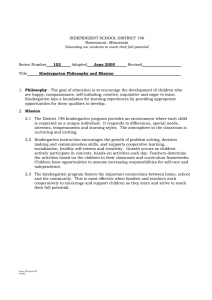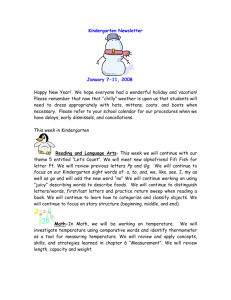7 Top 10 Signs of a Good Kindergarten Classroom
advertisement

Release #12 Top 10 Signs of a Good Kindergarten Classroom Kindergarten is a time for children to expand their love of learning, their general knowledge, their ability to get along with others, and their interest in reaching out to the world. While Kindergarten marks an important transition from preschool to the primary grades, it is important that children still get to be children—getting kindergarteners ready for elementary school does not mean substituting academics for play time, forcing children to master first grade “skills,” or relying on standardized tests to assess children’s success. Kindergarten “curriculum” actually includes such events as snack time, recess, and individual and group activities in addition to those activities we think of as traditionally educational. Developmentally appropriate kindergarten classrooms encourage the growth of children’s selfesteem, their cultural identities, their independence and their individual strengths. Kindergarten children will continue to develop control of their own behavior through the guidance and support of warm, caring adults. At this stage, children are already eager to learn and possess an innate curiosity. Teachers with a strong background in early childhood education and child development can best provide for children what they need to grow physically, emotionally, and intellectually. Here are 10 signs of a good kindergarten classroom: 1 Children are playing and working with materials or other children. They are not aimlessly wandering or forced to sit quietly for long periods of time. 2 Children have access to various activities throughout the day, such as block building, pretend play, picture books, paints and other art materials, and table toys such as legos, pegboards, and puzzles. Children are not all doing the same things at the same time. 7 Children have an opportunity to play outside every day that weather permits. This play is never sacrificed for more instructional time. 8 Teachers read books to children throughout the day, not just at group story time. 9 Curriculum is adapted for those who are ahead as well as those who need additional help. Because children differ in experiences and background, they do not learn the same things at the same time in the same way. 10 Teachers work with individual children, small groups, and the whole group at different times during the day. They do not spend time only with the entire group. 3 Children and their parents look forward to school. Parents feel safe sending their child to kindergarten. Children are happy; they are not crying or regularly sick. 4 Individual kindergarten classrooms will vary, and curriculum will vary according to the interests and backgrounds of the children. But all developmentally appropriate kindergarten classrooms will have one thing in common: the focus will be on the development of the child as a whole. The classroom is decorated with children’s original artwork, their own writing with invented spelling, and dictated stories. 5 Children learn numbers and the alphabet in the context of their everyday experiences. Exploring the natural world of plants and animals, cooking, taking attendance, and serving snack are all meaningful activities to children. 6 Children work on projects and have long periods of time (at least one hour) to play and explore. Filling out worksheets should not be their primary activity. Additional Resources: Good teaching practices for older preschoolers and kindergarteners. 1990. Washington, DC: NAEYC #522. 50¢ each/100 for $10. Spanish edition, Prácticas de enseñanza apropriados para niños mayores en pre-escolar y kinder, #523. Peck, J., G. McCaig & M.E. Sapp, Kindergarten policies: What is best for children? Washington, DC: NAEYC. #141/$6. NATIONAL ASSOCIATION for the EDUCATION of YOUNG CHILDREN 1509 16th Street, N.W., Washington, DC 20036-1426 202–232–8777 800–424–2460 FAX: 202–328–1846 Copyright © 1996 by National Association for the Education of Young Children. Reproduction of this material is freely granted, provided credit is given to the National Association for the Education of Young Children.




